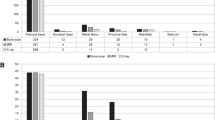Abstract
Objectives
To describe the imaging findings on computed tomography (CT) and skeletal survey (SS) in patients with POEMS syndrome.
Methods
We retrospectively reviewed, with institutional review board approval, the dysproteinemia database at our institution for patients with new diagnosis of POEMS syndrome between January 1998 and December 2008. Twenty-four patients were identified with PET/CT or CT and had skeletal survey (SS) available for review.
Results
Twenty-four patients were included in the study group with median age of 47 years. All CTs demonstrated at least one sclerotic lesion. The most common pattern was multiple small lesions, with 18 patients (75 %) having at least 5 lesions less than 1 cm. The larger lesions had a central lytic component and were FDG avid. SS had a false negative rate of 36 % (8 patients). Serial CT after treatment showed a decrease in size and number of sclerotic lesions in 53 % of cases (13 patients), the majority showing increased sclerosis. Two patients had complete resolution of sclerotic lesions.
Conclusions
CT identified sclerotic lesions in all study patients with POEMS syndrome, the majority being less than 1 cm in size, which were not identified radiographically. CT may demonstrate increased sclerosis or even resolution of sclerotic lesions corresponding to treatment response.
Key Points
• CT has high sensitivity in identifying sclerotic lesions in POEMS syndrome
• Most common CT patterns are multiple, less than 1 cm, sclerotic lesions
• Larger lesions have lytic centres and sclerotic margins
• Skeletal surveys may have a false negative rate of 36 %
• Treatment response includes increased sclerosis, decrease in size or resolution of lesions




Similar content being viewed by others
References
Bardwick PA, Zvaifler NJ, Gill GN, Newman D, Greenway GD, Resnick DL (1980) Plasma cell dyscrasia with polyneuropathy, organomegaly, endocrinopathy, M protein and skin changes: the POEMS syndrome: report on two cases and a review of the literature. Medicine 9:311–322
Dispenzieri A (2011) POEMS syndrome: 2011 update on diagnosis, risk-stratification, and management. Am J Hematol 86:592–601
Dispenzieri A, Kyle RA, Lacy MQ, Rajkumar SV, Therneau TM, Larson DR, Greipp PR, Witzig TE, Basu R, Surarez GA, Fonseca R, Lust JA, Gertz MA (2003) POEMS syndrome: definitions and long-term outcome. Blood 101:2496–2506
Resnick D, Greenway GD, Bardwick PA, Zvaifler NJ, Gill GH, Newman DR (1981) Plasma-cell dyscrasia with polyneuropathy, organomegaly, endocrinopathy, M-protein and skin changes: the POEMS syndrome. Radiol 140:17–22
Alberti MA, Martinez-Yelamos S, Fernandez A, Vidaller A, Narvaez JA, Cano LM, Gamez C, Martinez-Matos JA (2010) 18F-FDG PAT/CT in the evaluation of POEMS syndrome. Eur Radiol 76:180–182
Montoriol PF (2011) Two more cases of evaluation of POEMS syndrome using 18-FDG PET/CT. Eur Radiol 80:861–864
Shibuya K, Misawa S, Horikoshi T, Kanai K, Isose S, Nasu S, Sekiguchi Y, Noto Y, Fujimaki Y, Nakaseko C, Kuwabara S (2011) Detection of bone lesions by CT in POEMS syndrome. Intern Med 50:1393–1396
Narvaez JA, Majos C, Narvaez J, Valls C, Fernandez-Cabrera L (1998) POMES syndrome: unusual radiographic, scintigraphic and CT features. Eur Radiol 8:134–136
Li J, Zhou DB, Huang Z, Jiao L, Duan MH, Zhang W, Zhao YQ, Shen T (2011) Clinical characteristics and long-term outcome of patients with POEMS syndrome in China. Ann Hematol 90:819–826
Aggarwal S, Kumar Goulatia R, Sood A, Prasad K, Kumar Ahuja G, Mitchell MJ, Kumar A (1990) POMES syndrome: a rare variety of plasma cell dyscrasia. AJR 155:339–341
Stefanelli A, Treglia G, Leccisotti L, Laurentii L, Luigetti M, Sabatelli M, Giordano A (2012) Usefulness of F-18 FDG PET/CT in the follow-up of POEMS syndrome after autologous peripheral blood stem cell transplantation. Clin Nuc Med 37:181–183
D’Souza A, Lacy M, Gertz M, Kumar S, Buadi F, Hayman S, Dingli D, Zeldenrust S, Kyle R, Ansell S, Inwards D, Johnston P, Micallef D, Porrata L, Litzow M, Gastineau D, Jogan W, Dispenzieri A (2012) Long-term outcomes after autologous stem cell transplantation for patients with POEMS syndrome (osteosclerotic myeloma): a single-center experience. Blood 120:56–62
Greenspan A (1995) Bone island (enostosis); current concept—a review. Skelet Radiol 24:111–115
Chong ST, Beasley HS, Daffner RH (2006) POEMS syndrome: radiographic appearance with MRI correlation. Skelet Radiol 35:690–695
Grover SB, Dhar A (2000) Imaging spectrum in sclerotic myelomas: an experience of three cases. Eur Radiol 10:1828–1831
Li J, Zhou D (2013) New advances in the diagnosis and treatment of PEOMS syndrome. Br J Hematol 161:303–315
Soubrier MJ, Dubost JJ, Sauvezie BJ (1994) POEMS syndrome: a study of 25 cases and a review of the literature. French Study group on POEMS syndrome. Am J Med 97:543–553
Humeniuk MS, Gertz MA, Lacy MQ, Kyle RA, Witzig TE, Kumar SK, Kapoor P, Lust JA, Hayman SR, Buadi FK, Rajkumar V, Zeldenrust SR, Russell SJ, Dingli D, Lin Y, Leung N, Dispenzieri A (2013) Outcomes of patients with POEMS syndrome treated initially with radiation. Blood 122:68–73
Acknowledgements
The authors wish to thank Dr Paul Frohnert for his help with data collection and Mr Peter McAnally for help with manuscript preparation. The scientific guarantor of this publication is Katrina Glazebrook. The authors of this manuscript declare no relationships with any companies whose products or services may be related to the subject matter of the article. The authors state that this work has not received any funding. No complex statistical methods were necessary for this paper. Institutional review board approval was obtained. Written informed consent was waived by the institutional review board. Methodology: retrospective, observational, performed at one institution
Author information
Authors and Affiliations
Corresponding author
Rights and permissions
About this article
Cite this article
Glazebrook, K., Guerra Bonilla, F.L., Johnson, A. et al. Computed tomography assessment of bone lesions in patients with POEMS syndrome. Eur Radiol 25, 497–504 (2015). https://doi.org/10.1007/s00330-014-3428-y
Received:
Revised:
Accepted:
Published:
Issue Date:
DOI: https://doi.org/10.1007/s00330-014-3428-y




